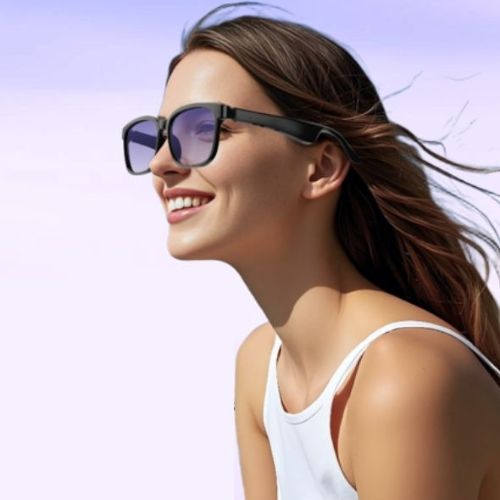
Headphones were once humanity’s armor against noise, but they have gradually become a shackles of modern life—swollen ear bones, the panic of missing a subway stop, the embarrassment of sudden disconnections… When a pair of glasses can simultaneously address the four major needs of listening, communication, health, and safety, perhaps it’s time to rethink: should the carrier of sound return to the most natural way of wearing?
Pain Points:
- Hearing Damage: According to WHO data, wearing headphones for more than an hour a day increases the risk of hearing loss by 28% after five years.
- Ear Canal Infections: In-ear headphones carry bacteria approximately 3 times more than a toilet seat (according to research from Medical Microbiology).
- Physical Injury: 73% of users experience ear cartilage indentation or swelling (2023 wearable device survey).
Solution: Smart Audio Glasses:
- Open Listening: Open-ear + air-conduction dual-mode technology allows for 30% reduced volume while maintaining clarity.
- Zero-Contact Wear: Sound is transmitted through the temples, leaving the ear canal completely free to breathe.
- Comfort for Extended Use: With a weight of just 33.5g, the load is distributed across the cheekbones and nose bridge, leaving no pressure marks after 12 hours.
- The “Cage” of Earphones: The secondary issues created by headphones.
Real-Life Dilemmas:
- Riding a bike with noise-canceling headphones: It’s dangerous not being able to hear honking behind you.
- In a meeting, hastily removing headphones: The awkward moment of yanking off earrings and causing an embarrassing scene.
- During exercise, headphones suddenly fall off: Searching for the “bean” (earbud) all over the gym floor.
Smart Audio Glasses Solution:
- Environmental Awareness Mode: ENC noise cancellation doesn’t block human voices or alarms. While cycling, wind noise is reduced, but car horns are enhanced.
- Seamless Interaction: A light tap or double-tap on the temples to answer calls, long press for 2 seconds to reject, keeping social interactions smooth.
- Physical Anti-Loss: The temples naturally fit the face, tested to run 10 kilometers without falling off.
Efficiency Traps:
- The Life Split by Headphones:
- Frequent Removal: On average, users remove and put on their headphones 23 times a day, wasting 8.7 minutes.
- Device Switching: Switching between phone, computer, and tablet requires manual reconnection.
- Charging Anxiety: Forgetting to charge equals being cut off from the world.
- Social Isolation: Headphones create a “self-imposed isolation” barrier.
Social Side Effects:
- Wearing headphones = a cold “do not disturb” signal to others.
- The awkwardness of needing a tap on the shoulder in an emergency to get attention.
- Repeatedly removing and putting on headphones during group conversations is rude.
Smart Audio Glasses Wisdom:
- Transparency Mode: Ambient sounds naturally blend in, allowing communication with colleagues without removing the device.
- Breathing Light Language: The light on the temples notifies you of incoming calls/messages, elegant and non-disruptive.
- Privacy Protection: Directional sound technology ensures that conversations are inaudible outside of a 3cm radius.
Aesthetic Dilemma: The Ultimate Battle Between Headphones and Image:
- Styling Conflict:
- Headphones flatten a meticulously styled hairstyle.
- In-ear headphones disrupt the aesthetic design of earrings.
- Sports headphones don’t go well with formal attire.
Smart Audio Glasses Evolution:
- Invisible Sound Field: Preserves your hairstyle and makeup, perfectly fitting in business settings without awkwardness.
- Customizable Accessories: Interchangeable temples, magnetic lens clips (sunglasses/night vision attachments).
User Awakening Moments:
- Programmer, Mr. Zhang: “After wearing headphones for 5 hours of coding, I experienced tinnitus. After switching to TendoPlay glasses, my hearing test returned to normal.”
- Cycling Enthusiast: “Listening to music with an open-ear design while still being able to clearly hear cars behind me—finally, safety and enjoyment are both achievable.
Why is this the inevitable choice?
When technology begins to align with the human body, rather than modifying it:
-
- More intuitive: Sound should naturally come from the front of the head, not block the ear canal.
- More human-centered: No need to compromise between safety, sound quality, and health.
- More elegantly integrated into life: Technology finally learns to blend seamlessly into everyday living.


